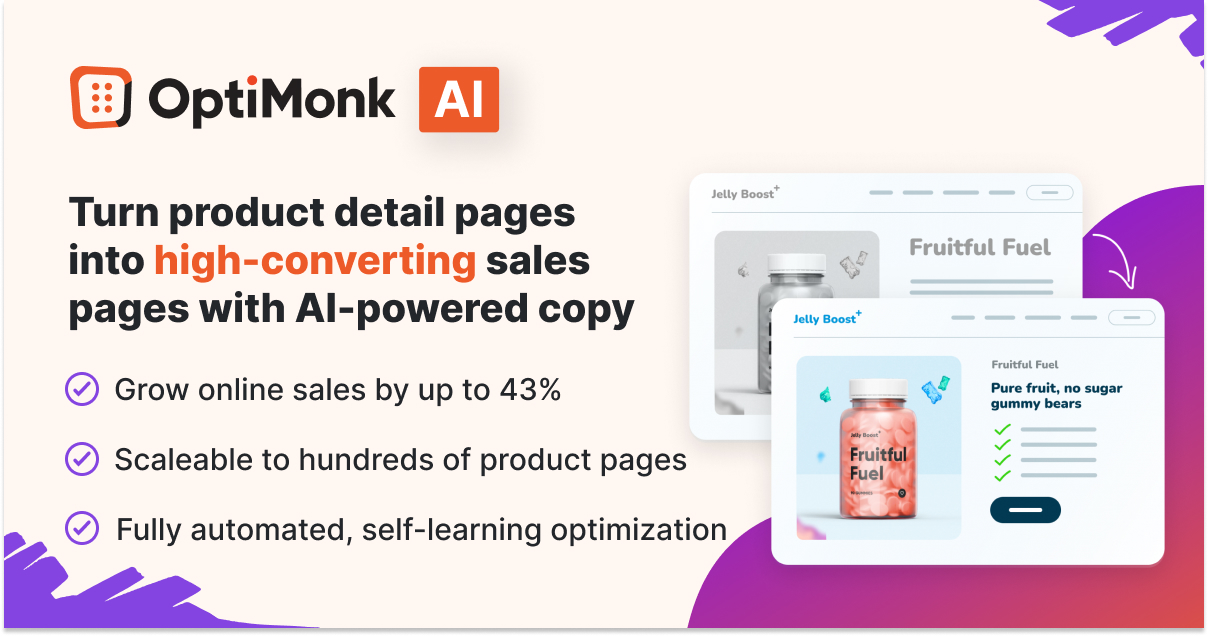- Blog
- How to Write Effective Ecommerce Product Descriptions (With 17 Examples)
How to Write Effective Ecommerce Product Descriptions (With 17 Examples)
-
Nikolett Lorincz
- Ecommerce
- 6 min read
Table of Contents
Many ecommerce businesses don’t give product descriptions the attention they deserve, instead treating them as an afterthought.
However, the truth is that compelling product descriptions can make all the difference, turning a casual browser into a committed buyer.
In this article, we’ll dive into the art of writing product descriptions for your online store. We’ll also go over 17 product description examples that can help get you started.
Whether you’re just starting out or looking to revamp your current listings, these tips will help you create your own product descriptions that not only inform but also entice.
Let’s jump right in!
What is a product description and why does it matter in ecommerce?
A product description is a short piece of marketing copy that explains what a product is, what it does, and why someone should buy it. It highlights key features and benefits, helping shoppers understand how the product fits their needs.
In ecommerce, product descriptions are critical because they act as a virtual salesperson. A clear, well-written description builds trust, answers buyer questions, and can directly influence purchasing decisions—especially when customers can’t physically interact with the product.
Product descriptions usually contain a rundown of a product’s features, key attributes, and benefits. By the time a website visitor finishes reading a product description, they should know exactly what problem the item is meant to solve and how it does so.
Effective product descriptions not only describe what a product does but also highlight how it stands out from competing products, often emphasizing its uniqueness and value proposition.
Well-written product descriptions help potential customers get the information they need and persuade them to make a purchase.
Later, we’ll take a look at several successful product description examples, but for now, here’s a product description example from Stanley using power words and highlighting the product benefits perfectly.
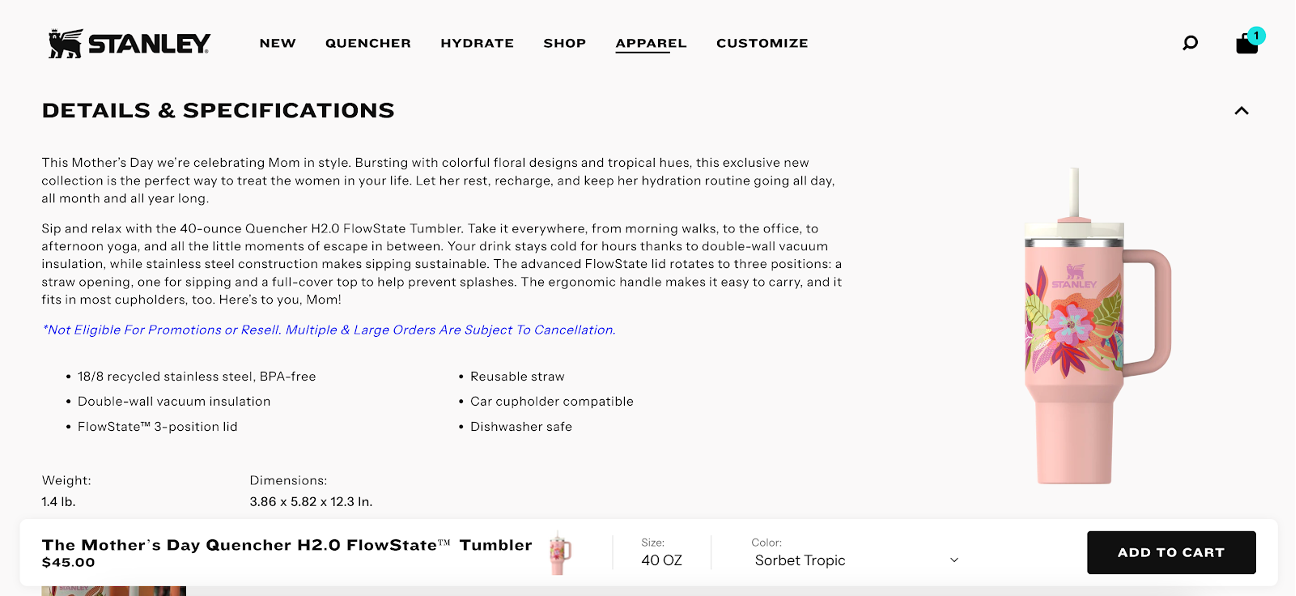
Why do product descriptions affect conversions?
Product descriptions play a key role in turning browsers into buyers. They help potential customers quickly understand why a product is right for them—especially when they’re unfamiliar with the features or technical specs.
Many store owners assume shoppers already understand the product, but that’s rarely the case. A good product description bridges that gap by translating features into real-life benefits and creating a sense of desire or urgency to buy.
Well-crafted product descriptions also play a vital role in search engine optimization (SEO), helping businesses improve their online visibility and attract potential buyers to their websites.
You just need to stop sounding like a brochure. Pull a line from a real conversation, a moment someone might actually say out loud. This approach works because people don’t buy just to own something—they buy to solve a problem or feel a certain way. If the words in the product description help them feel that moment early, they’re more likely to click buy.

Michael Nemeroff
Co-founder & CEO
How do you write a great product description in 2025?
Now, let’s break down how to write product descriptions. By following these six steps, you’ll be able to highlight your product’s benefits and create an effective product description.
1. Know your target audience
Before you jump into writing product descriptions, do some research about your ideal customers and create a buyer persona that includes demographics, behavior, preferences, and pain points.
Always remember that you’re not writing for everyone, you’re writing for your ecommerce business’ target customer. Try to think about the type of language your ideal customer will respond to.
2. Highlight product features and benefits
Outline the main product benefits and features in just a few sentences, focusing on the aspects that set your product apart, making it irresistible.
You also want to include all the technical details and specifications that a potential customer will need to see in order to make an informed purchase decision.
3. Use your brand voice and incorporate storytelling
Make sure that your brand’s unique voice comes through in your product descriptions. It should be memorable, recognizable, and aligned with your target audience’s typical way of speaking (and their values).
Creative product descriptions that include a bit of storytelling can help your users imagine how the product will fit into their lives, making them more likely to buy.
4. Don’t forget keyword optimization
Search engine optimization is a key part of product description writing, since the better your product’s organic search rankings, the more traffic will land on your ecommerce site.
Since so many online shoppers use search engines to find products, doing your keyword research and optimizing your product descriptions is an easy way to increase sales.
5. Pay attention to formatting and readability
Writing high-quality product descriptions is all about packing a lot of relevant information into a small space.
A short paragraph with a few bullet points helps the visitors scan the product’s features. You can also emphasize key points in bold to further increase scannability.
6. Use clear language
Finally, you want to avoid using jargon in your product descriptions, as this can cause potential buyers to get bored and leave the page. Clear, simple language is always best.
You should also be honest and transparent about your products and avoid misrepresenting their features.
17 great examples of product descriptions
Now that we’ve gone over the theory behind writing a creative product description, let’s take a look at 17 product description examples to give you some inspiration!
1. Muscle Feast
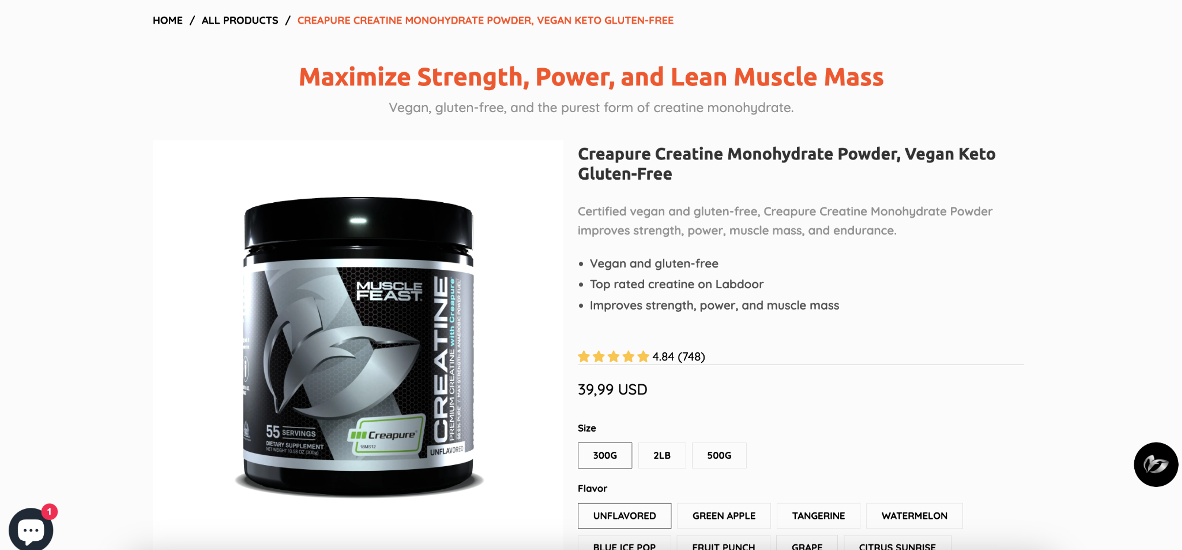
Muscle Feast’s product description is a shining example of how to effectively engage your audience and convey the unique selling points of your product. Their concise yet powerful approach is something worth emulating for your ecommerce store.
They excel in capturing the attention of their target audience by focusing on the key benefits of the product, while they effectively address the concerns of health-conscious consumers, making it clear that this product is suitable for a broader audience, including those with dietary restrictions.
They use short sentences and bullet points in the product description, which is crucial for a couple of reasons:
- Most people have limited time and attention spans, making it unlikely that they’ll read through lengthy paragraphs of product details. By keeping the content concise and to the point, you increase the likelihood that people will read it and understand it.
- People tend to skim through product descriptions, focusing on the first and last few lines. Therefore, it’s essential to capture their attention and convey the most important information quickly.
2. Solagarden
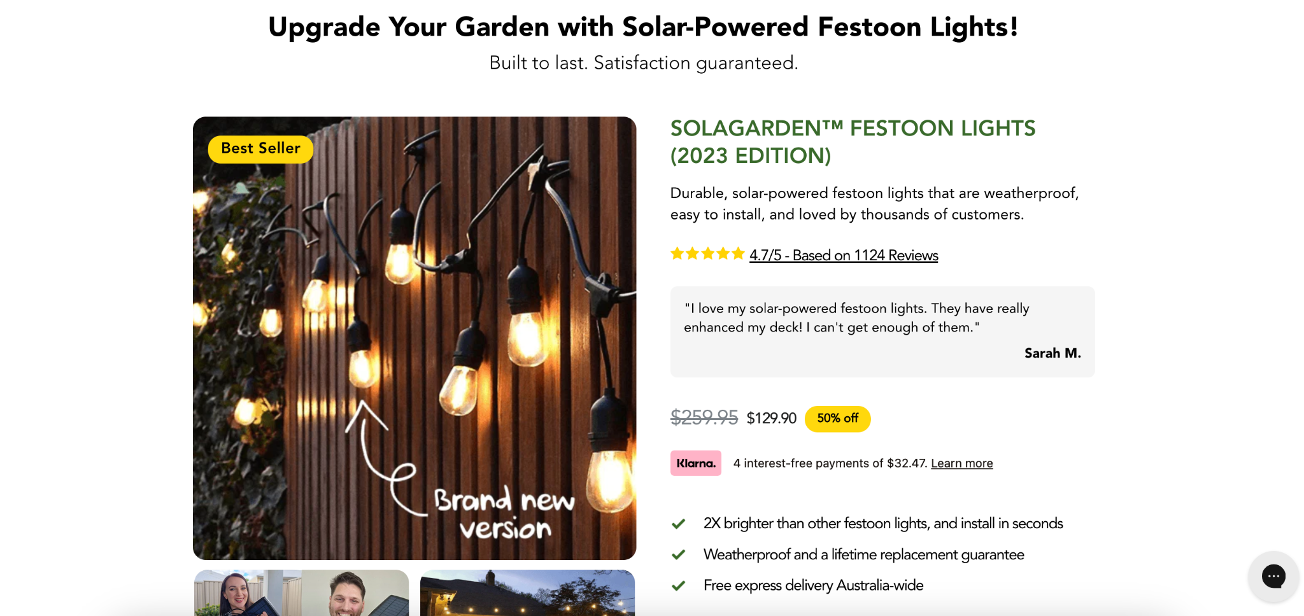
When it comes to captivating customers and addressing their needs, SolaGarden knows what they’re doing. Their product description for solar-powered festoon lights hits all the right notes.
They have a great headline at the top, a concise and benefit-driven product description, and a positive customer testimonial—all of these together provide essential product information and appeal to the needs and desires of their customers.
In fact, SolaGarden witnessed a 10.9% increase in revenue by adding these three new elements to its product pages. Read how they did it here!
3. Vegetology
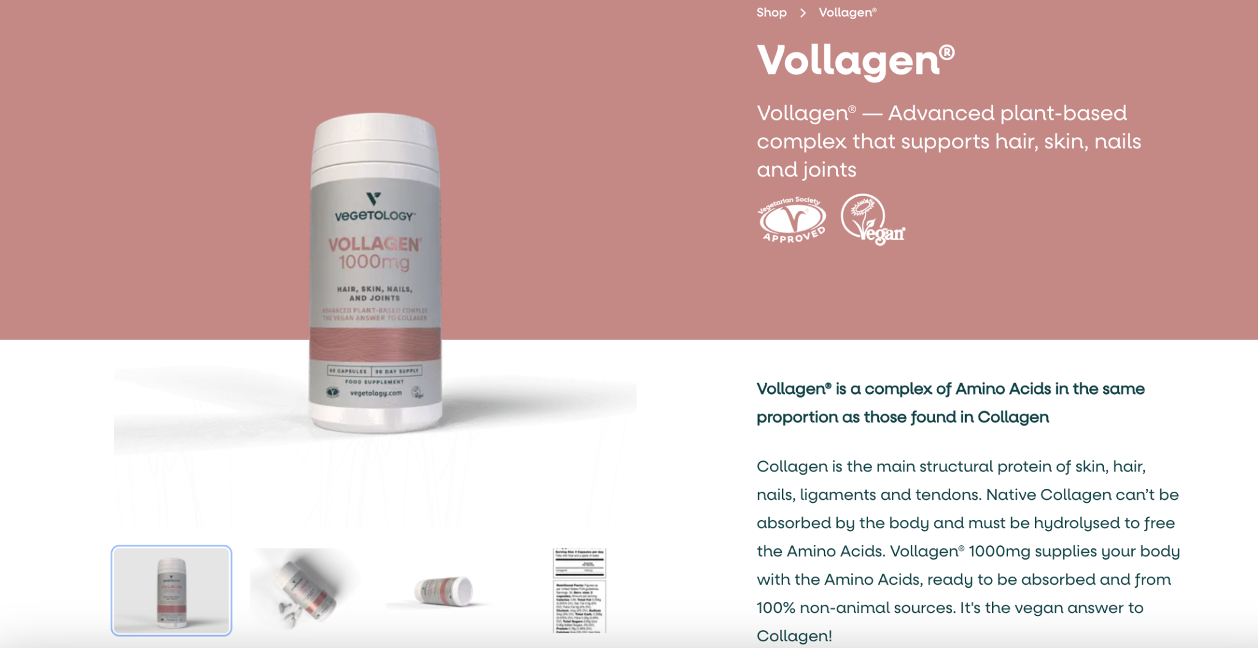
Vegetology has masterfully crafted a product description that not only captures the essence of its innovation but also speaks directly to its customers.
When it comes to effective product descriptions for your online store, this one from Vegetology excels as a prime example. Here’s why:
- They acknowledge the problem their audience faces.
- They highlight the benefits users can expect after incorporating Vollagen® into their routine.
- They make it clear that their product is tailor-made for a specific demographic: individuals seeking a vegan alternative to traditional collagen products.
4. Gymshark

Gymshark’s product description is concise and impactful. It’s free of technical jargon and focuses on the target audience, which is fitness enthusiasts.
It begins with a motivational message about champions and implies that their product is designed for those who strive to be different, strong, and exceptional.
This introduction immediately engages the reader’s emotions and sets the tone for the rest of the description. Below this, they provide key features and benefits of the product.
Gymshark’s example shows how breaking information into chunks can greatly improve the readability of a product description. By presenting information in smaller sections, it becomes easier for customers to navigate and consume the content.
5. Bose
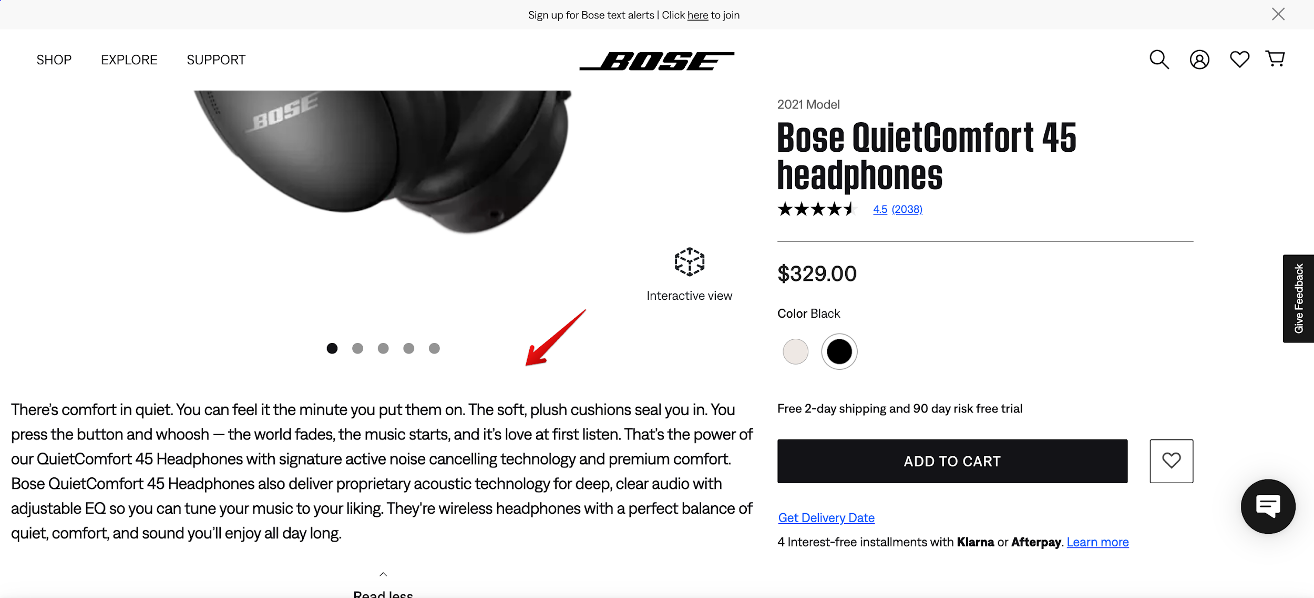
In this product description example, Bose speaks to their target audience directly by using evocative words to tap into feelings.
There’s also a video that highlights the special features of the headphones they’re selling. Videos can be a very engaging way of communicating complex information effectively.
6. KitchenAid
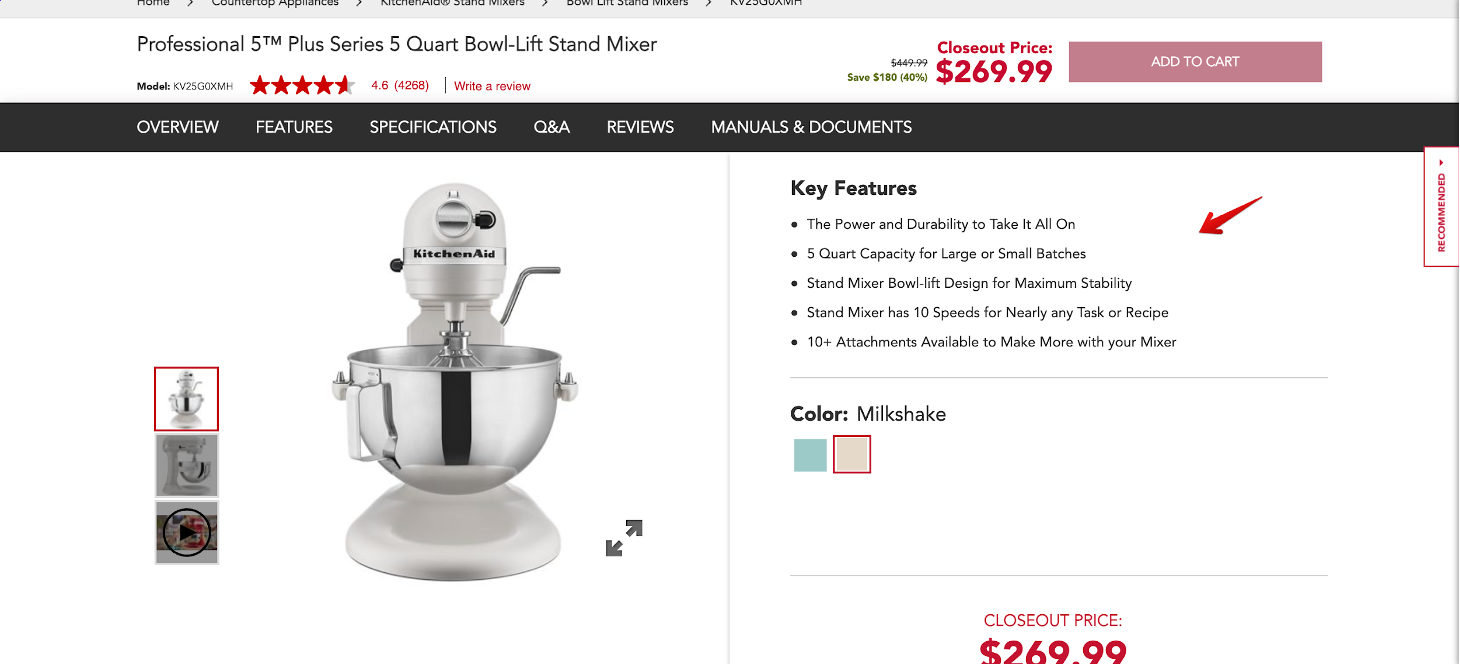
This page is a great example of how bullet points can communicate a lot of information in an easy-to-read manner. All the relevant product details are covered in a very limited amount of space.
Another feature of this product page is the notification that 45 people recently purchased this product, which can create a sense of FOMO.
7. Fitbit
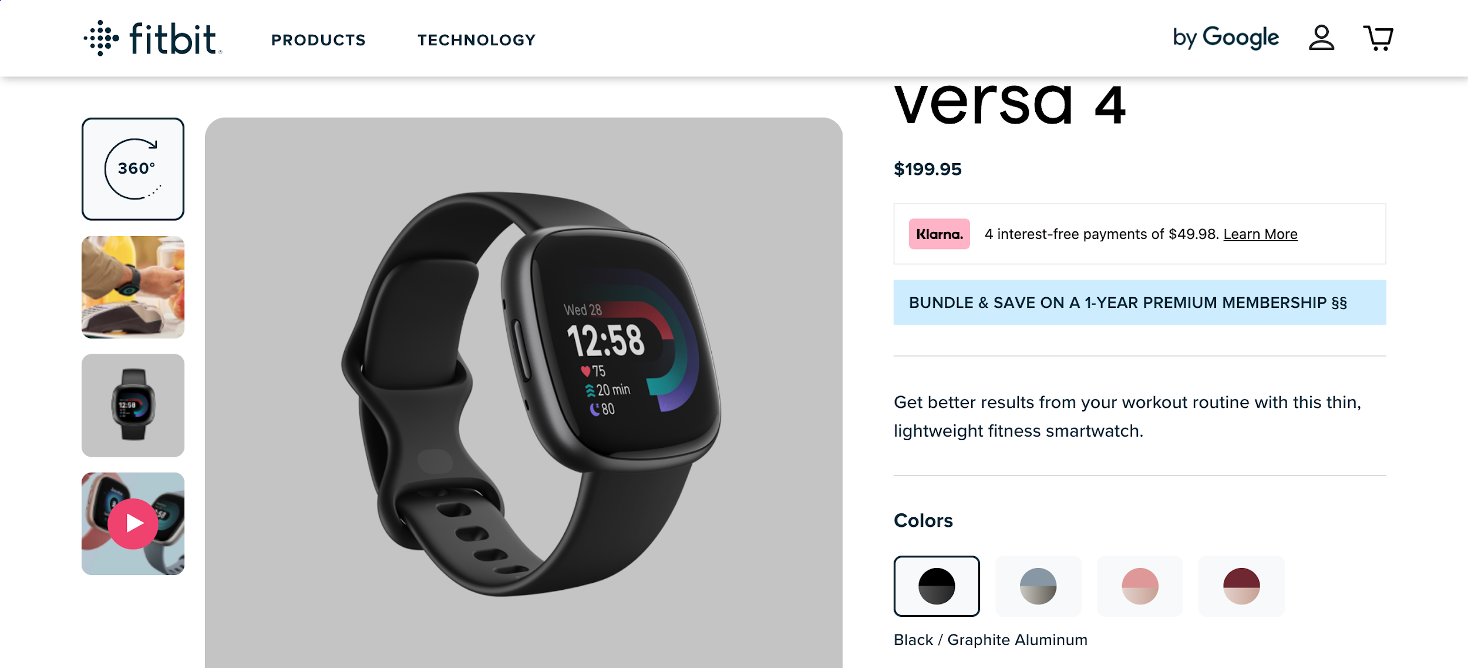
The product description on this page is a simple one-sentence summary of the watch and what to expect from it.
If you’re an online business with a very high profile and brand recognition like Fitbit, sometimes that’s all you need!
This minimalist approach allows for clarity and conciseness in communication. By using fewer words, your product description can effectively convey the necessary information without overwhelming customers.
8. Patagonia
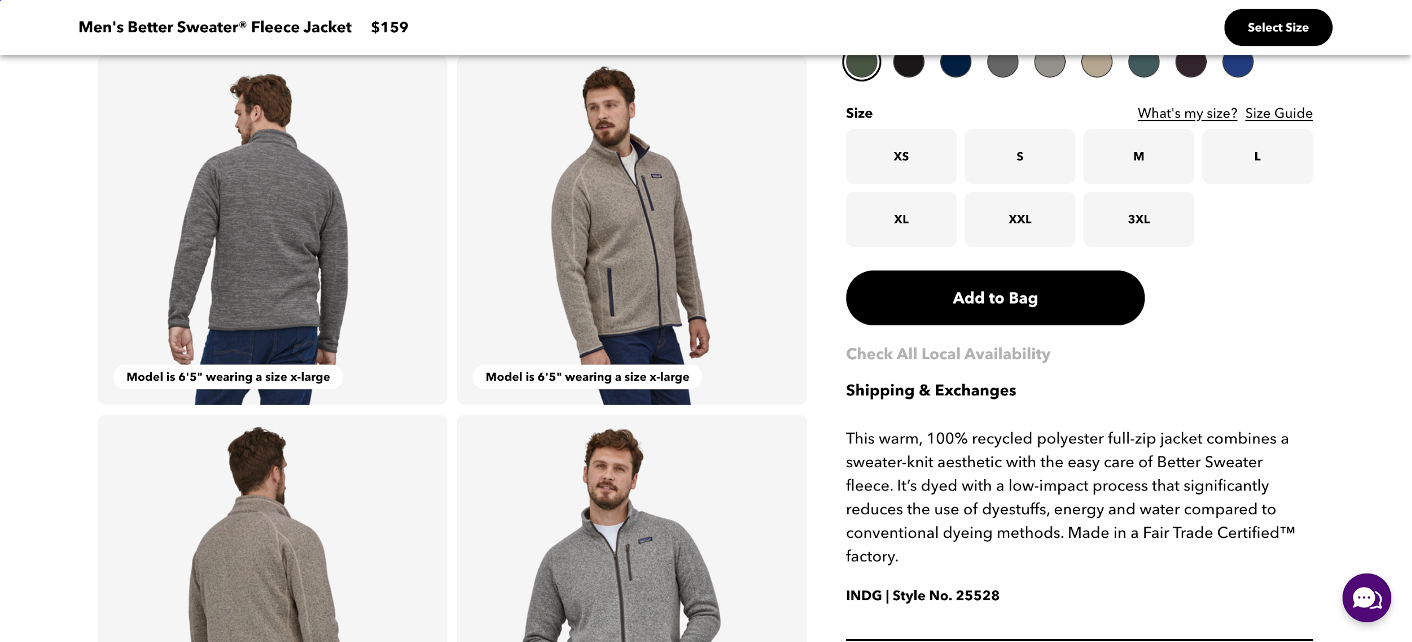
This clothing product description includes all the information a consumer needs to understand why it’s a “Better Sweater” than the competition.
The product and the material itself are described using evocative power words in a way that goes perfectly with the product images on display.
9. Le Creuset
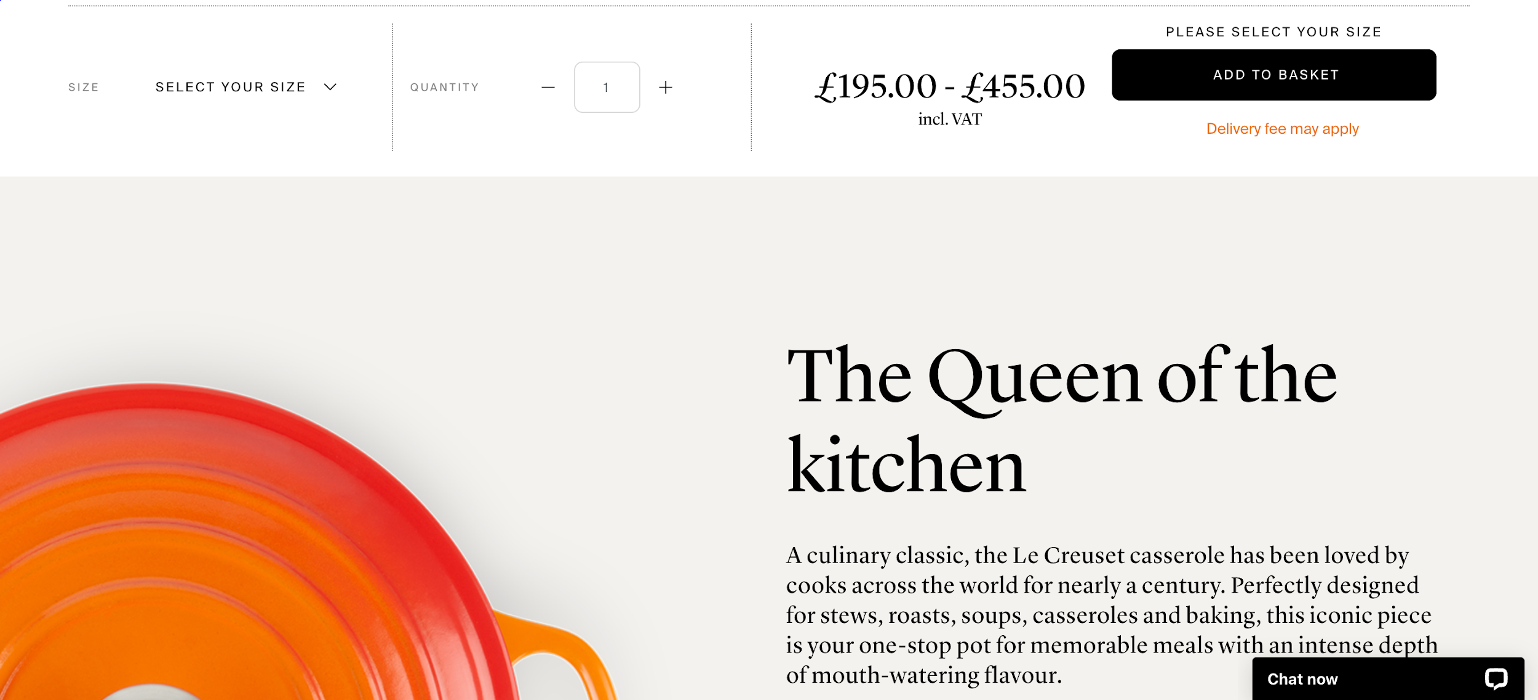
Sometimes you don’t need to go overboard with key features and technical specs.
In this example from Le Creuset, the tagline, “The Queen of the Kitchen” and the clever marketing copy tells a compelling story about the history and uniqueness of the product.
10. Fjallraven
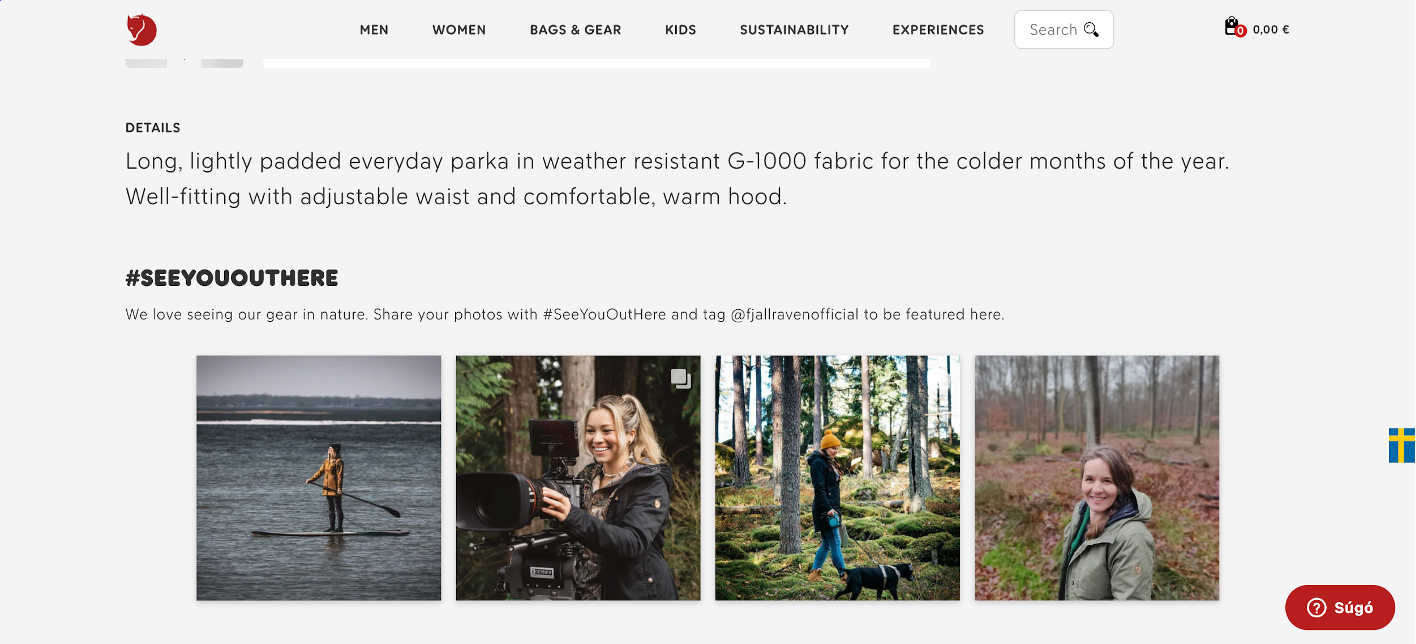
This product page combines a lot of the best practices we’ve gone over. It features a short, clean product description that tells exactly how the product will improve the customer’s life.
It also has attractive product images and social proof.
11. MyProtein

MyProtein gets that shoppers don’t want to read—they want to see. Their use of icons on product pages makes it easy to spot key features like breathability, sweat-wicking, and softness in seconds.
It’s smart UX: less scrolling, more clarity. The icons do the talking, and the short supporting text fills in just enough detail to drive confidence.
12. Kylie Cosmetics
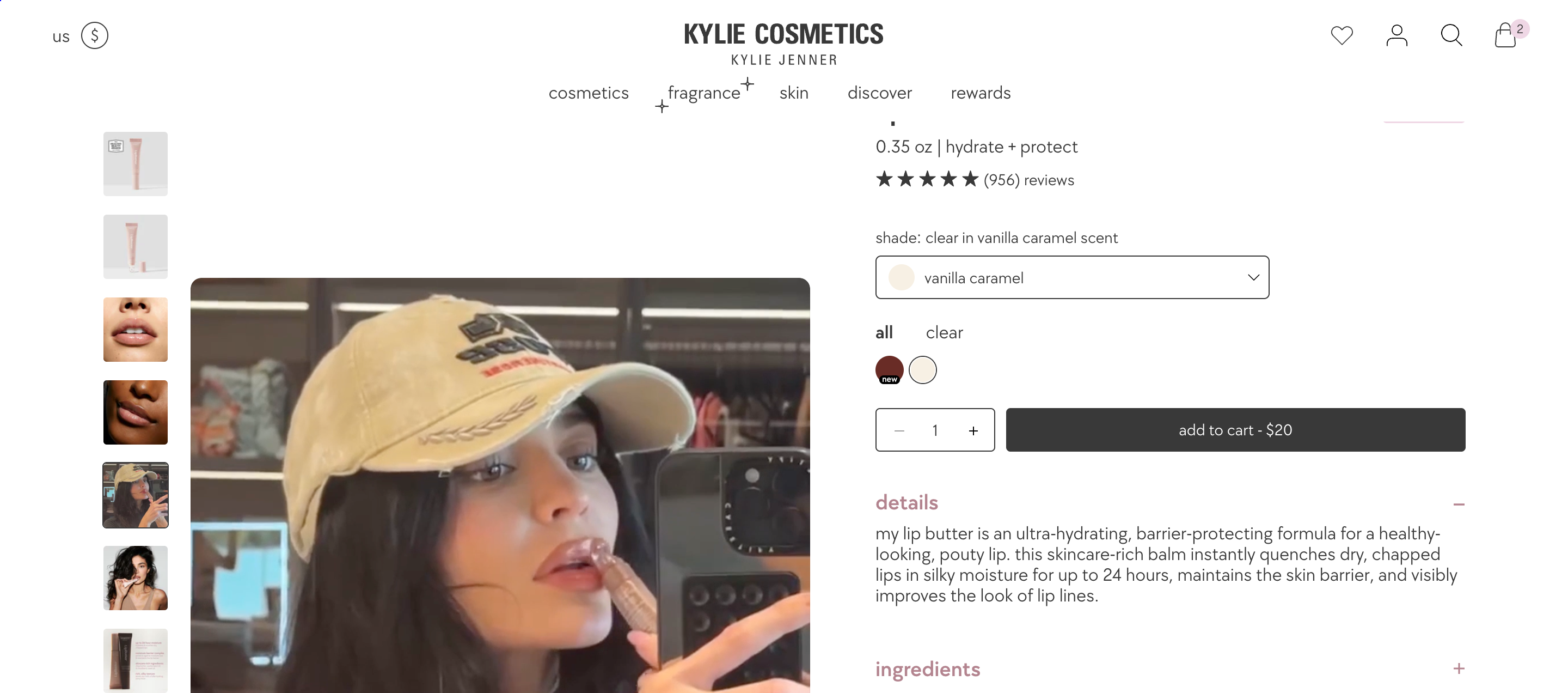
Kylie Cosmetics makes product descriptions feel personal. Saying “my lip butter” turns the copy into a conversation, not a sales pitch. It feels like a behind-the-scenes recommendation from Kylie herself, not a generic listing.
That small word choice builds trust and strengthens the brand’s connection with fans.
13. Kirrin Finch
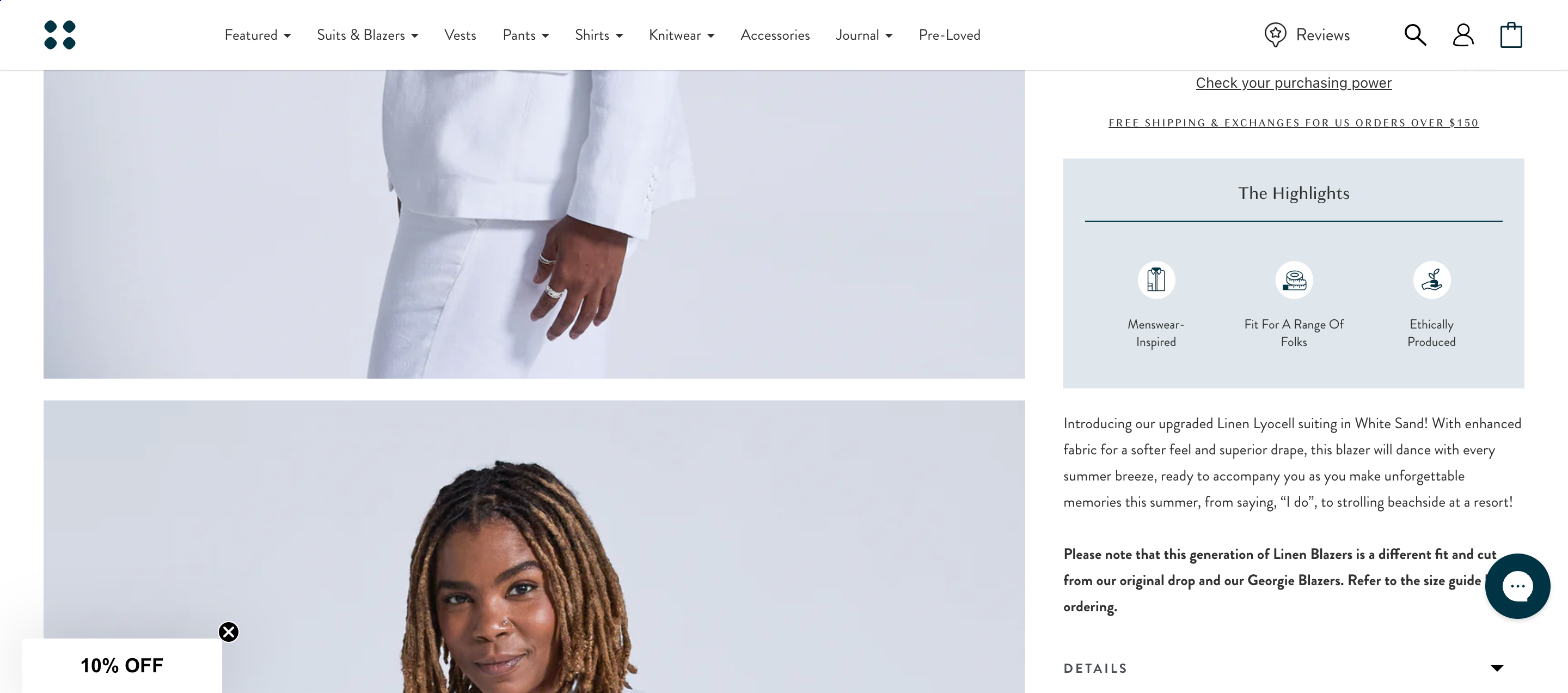
Kirrin Finch keeps it sleek and informative.
Their “Highlight” section at the top of each product page acts like a quick pitch—what it’s made of, how it fits, why it matters. It’s perfect for busy shoppers who want the essentials fast.
Below that, the full description is minimalist but detailed enough to answer practical questions.
14. Rhode

Rhode proves that less is more. Their blush description delivers just what you need—it’s long-wear, lightweight, and non-greasy. That’s it. The tone is confident and direct, matching the brand’s cool, effortless vibe. It’s functional copy that respects your time.
15. Allbirds

Allbirds leads with feel-good values and feel-great comfort. Each product page starts with quick-hit highlights—sustainable materials, comfort-focused design, and daily wearability.
The language is casual and benefit-focused, making the shoes feel both smart and approachable. It’s branding that walks the talk.
16. Hannah & Henry
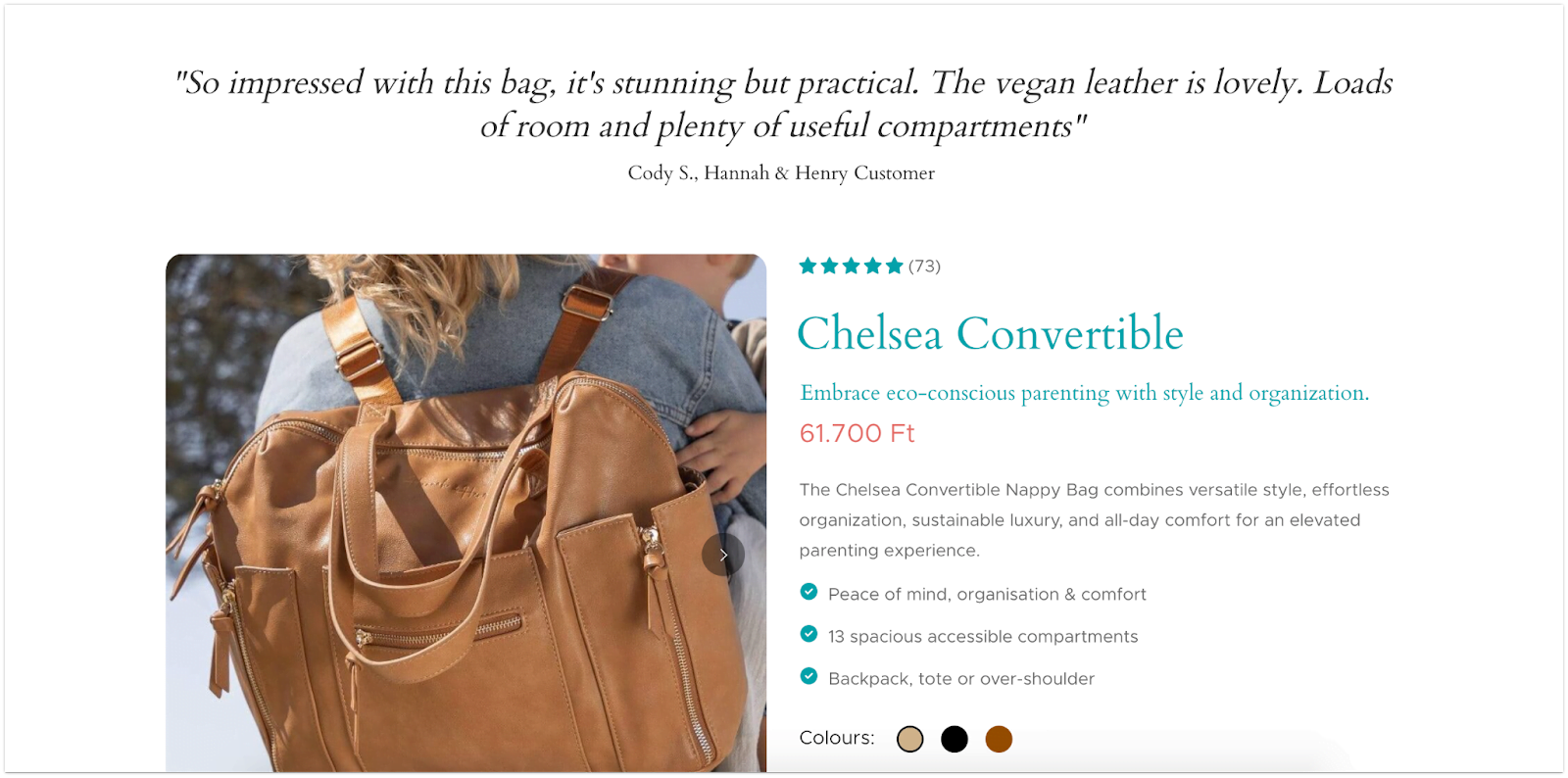
Hannah & Henry took a smart, scalable approach to upgrading their product pages. Instead of rewriting everything manually, they used the Smart Product Page Optimizer to generate compelling descriptions, catchy slogans, and pinpoint customer reviews that actually sell.
But they didn’t stop there—they A/B tested different versions of their product pages to see what really moved the needle. The clear winner? A page that included all three: a strong review, a standout slogan, and a concise, benefit-driven product description. The result was a page that felt authentic, engaging, and built for conversion.
It’s a great example of combining tech with testing to boost performance—without losing the brand’s voice.
17. Gelpro
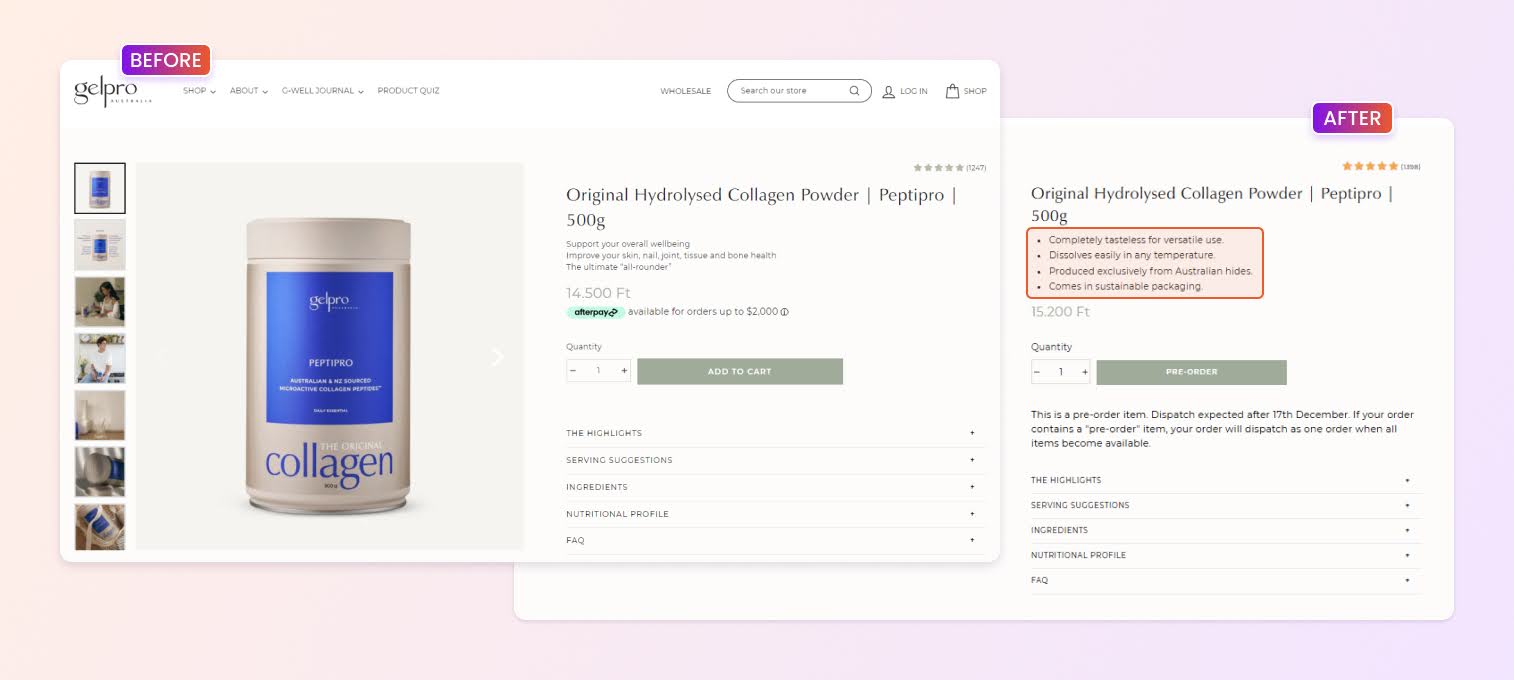
Gelpro ditched the long-form product copy in favor of clear, no-nonsense summaries and benefit lists. The goal? Make product pages more scannable, transparent, and user-friendly—especially for quick decision-makers.
To back it up, they ran an A/B test comparing different content formats. On desktop, the benefit list crushed it—driving a 30% increase in ecommerce conversions. Shoppers didn’t need to wade through paragraphs; the value was right there, bullet-pointed and bold.
It’s a great reminder: sometimes less copy, more clarity is what actually sells.
Boost your product pages with the power of AI
Writing product descriptions for dozens or hundreds of product pages can seem like a huge chore. But not with OptiMonk’s Smart Product Page Optimizer.
This AI-powered tool is a great way to boost your efficiency, enabling you to write compelling product descriptions for every single product page without any manual work.
It can craft captivating headlines, bullet points, benefit lists, and product descriptions all on its own. Since it requires very little from you in terms of time or effort, it’s a scalable solution that you can use to improve hundreds or thousands of product pages in one fell swoop.
Using this tool, Varnish & Vine was easily able to turn product pages that were converting at an average rate into high-converting product pages. In fact, they increased their revenue by 43%.
If you’d like to learn more about Smart Product Page Optimizer, click here.
FAQ
How can you create product descriptions that stand out from the competition?
To create a product description that stands out from the competition, focus on highlighting unique features and benefits, use persuasive language that resonates with your shoppers, and incorporate storytelling elements to make the product come to life. Additionally, ensure that your descriptions are well-structured, concise, free of errors, and optimized for the right keywords.
What is the ideal length of a product description?
The ideal length of a product description varies but generally falls between 150 to 300 words. It should be long enough to include essential details and benefits while remaining concise enough to hold the reader’s interest and ensure mobile-friendliness. However, the key is to strike a balance between information and readability, adapting the length to the complexity and uniqueness of the product.
How often should you update product descriptions?
Product descriptions should be regularly updated, especially when there are changes to the product, new customer feedback, or evolving market trends. Aim to review and refresh them at least every six months, but more frequent updates may be necessary for fast-changing industries or seasonal products. Consistent updates help keep your content accurate, engaging, and aligned with your customers’ needs and expectations.
How can you optimize your product description for search engines?
To optimize your product description for search engines, it’s crucial to incorporate relevant keywords that potential customers typically use when searching for products similar to yours. This can be achieved through thorough keyword research to identify these terms. Once you have a list of relevant keywords, strategically place them throughout your product description.
Wrapping up
In essence, product descriptions serve as a bridge between product features and customer needs, influencing purchasing choices while boosting a company’s online presence.
If you want to write great product descriptions for your ecommerce site, you need to balance all these functions.
Using the countless product description examples you can find on the internet and the ones you have seen in this article, you can write persuasive product descriptions for your ideal customer with all the relevant information needed.
Want to see more sales on all your product pages in no time at all? Give our Smart Product Page Optimizer a try!
Migration has never been easier
We made switching a no-brainer with our free, white-glove onboarding service so you can get started in the blink of an eye.

What should you do next?
Thanks for reading till the end. Here are 4 ways we can help you grow your business:
Boost conversions with proven use cases
Explore our Use Case Library, filled with actionable personalization examples and step-by-step guides to unlock your website's full potential. Check out Use Case Library
Create a free OptiMonk account
Create a free OptiMonk account and easily get started with popups and conversion rate optimization. Get OptiMonk free
Get advice from a CRO expert
Schedule a personalized discovery call with one of our experts to explore how OptiMonk can help you grow your business. Book a demo
Join our weekly newsletter
Real CRO insights & marketing tips. No fluff. Straight to your inbox. Subscribe now
Nikolett Lorincz
- Posted in
- Ecommerce
Partner with us
- © OptiMonk. All rights reserved!
- Terms of Use
- Privacy Policy
- Cookie Policy
Product updates: January Release 2025









